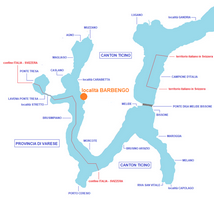Latitude: 45° 57' N |
Longitude: 8° 54' E |
Altitude: 370 m s.l.m. |
Inhabitants: 2.338 |
Barbengo, administratively municipality of Lugano, is situated between Morcote and Muzzano and is located south of Lugano. Until the fifteenth century it was called Premona, on its territory there is a fortified tower called "La Torrazza", probably in the Middle Ages connected to a castle currently in ruins (ruins of Castellaccio). In locality Cernesio of Barbengo there was one of the pink porphyry quarries of Ceresio, active until the 1940s, a very resistant natural stone with a pink color typical of the Lugano region with which many roads in the Canton of Ticino have been paved. You can visit Sant'Ambrogio's Parish Church of 1300, San Carlo Borromeo's Church of the end of the 19th century, San Francesco d'Assisi Oratory in locality Figino and Sant'Antonio Abate Oratory in locality Cadepiano.
Lugano is situated between Melide and locality Gandria, it's the largest city and main urban center of Canton Ticino, and it's the third financial center and an important congress, banking and business center in Switzerland; it is among the top ten Swiss cities by population and is also the city of parks, flower gardens, villas and religious buildings. It extends from the slopes of San Salvatore to Monte Brè up to the top of Gazzirola; the tourist resort is very popular and has also established itself worldwide as a leading international banking center, ranking third in Switzerland after Zurich and Geneva. Its historic center is full of Lombard-style buildings, colorful palaces and arcades that were once a place of commerce where fishermen spread their fishing nets and artisans exhibited their products for sale. Of ancient origins, starting from the Middle Ages it was continuously disputed between Como and Milan, in 1513 the city passed under the dominion of the Swiss while in 1798 it asked for and obtained independence by becoming part of the Swiss Confederation. In 1972 the Municipalities of Brè-Aldesago and Castagnola were aggregated and in 2004 the Municipalities of Breganzona, Cureggia, Davesco-Soragno, Gandria, Pambio-Noranco, Pazzallo, Pregassona and Viganello joined, while in 2008 Barbengo, Carabbia and Villa Luganese. You can visit the Ciani Civic Park, considered the green lung of the city with its 63.000 square meters of greenery, with centuries-old trees, well-kept gardens and flower beds with statues and fountains, famous for its wrought iron door, known as "door of the lake", a gate that is located right on the shore of the lake. Inside the park there is a playground for children and other important city buildings, including Villa Ciani, the Cantonal Museum of Natural History, the Palazzo dei Congressi and the Cantonal Library; the Cathedral of San Lorenzo, with its Renaissance-style facade which was completely renovated during the twentieth century: the bell tower, detached from the body of the building, is in Romanesque style and is surmounted by an octagonal dome. Inside you have to visit Madonna delle Grazie's Chapel, which houses an ancient source, a majestic high altar in marble and the altarpiece of the Madonna in glory with SS. Lorenzo and Rocco.
